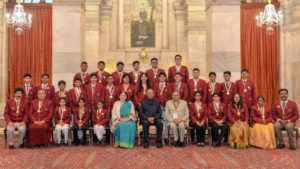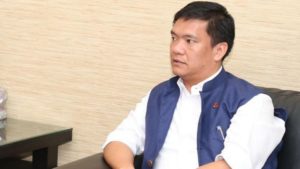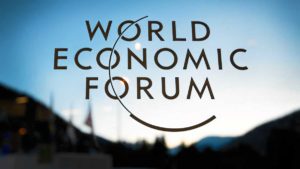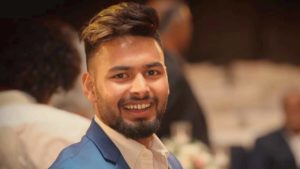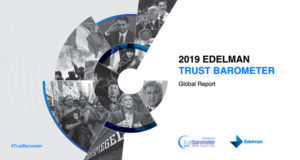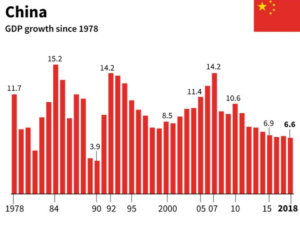VisionIAS
13:18

📰 Oral mentioning, the practice that triggered the master of roster row, may become a thing of the past in apex court
Oral mentioning is a convention by which lawyers short-circuit the long-winded filing procedures and make a direct appeal to the CJI, who is the court's administrative head and master of roster, for early hearing.
•The usual sight of lawyers crowding the courtroom of the Chief Justice of India in the mornings to orally mention their cases for urgent listing may soon become passé in the Supreme Court.
•Chief Justice of India Ranjan Gogoi on Wednesday informed a crowded courtroom, chock-a-block with lawyers lined up to get a word in, that new guidelines have been settled by which urgent cases would automatically come up before a Bench for hearing within four days of their being filed.
•"We are trying to get rid of urgent mentioning before the court, which unnecessarily takes away time," the Chief Justice said.
•If such cases did not come up for hearing, the lawyers concerned could make a mention before the Registrar to have their cases listed, he said.
•Oral mentioning is a convention by which lawyers short-circuit the long-winded filing procedures and make a direct appeal to the CJI, who is the court's administrative head and master of roster, for early hearing.
•The CJI takes a call on the spot, after glancing through the case papers, whether the case deserves to be heard out-of-turn. Hearing a case out-of-turn would mean pushing other cases off the list. The CJI has often complained about how a case orally represented by a lawyer during mentioning does not later, when the judges read the papers in detail, turn out to be as urgent as it was initially made out to be by the lawyer.
•"For over an hour everyday, the CJI is made to read the case papers just to see whether a case mentioned is important enough to deserve an urgent hearing...this is a waste of judicial time," Chief Justice Gogoi had once complained in court.
•In the past few years, oral mentioning has been both controversial and witnessed reforms.
•It was the oral mentioning of the Lucknow medical College scam case before Justice (now retired) J.S. Chelameswar that triggered the row about the CJI's powers as 'master of roster'.
•A writ petition was mentioned before Justice Chelameswar because then CJI Dipak Misra was heading a Constitution Bench that day. Justice Chelameswar ordered a Bench to be formed to hear the petition. This order was countermanded that very afternoom by a Constitution Bench, which held that none but the CJI has the authority to allocate cases and set up Benches.
•The convention also went through a positive transformation when Justice Dipak Misra realised how senior advocates use their heft in court to take advantage over other lawyers to get early dates during oral mentioning. Justice Misra had made it a level playing field for all lawyers by allowing only advocates-on-record to mention cases.
•Justice Gogoi has repeatedly advised the Bar to be circumspect about orally mentioning cases, and be careful that only absolutely urgent cases are brought before him. He reminded lawyers that the court cannot be seen to be wasting time when hundreds of death penalty cases are waiting for years to be heard.
📰 India conducts coastal security drill
Tests preparedness along coastline
•Ten years after the 26/11 Mumbai terror attack, India conducted its largest coastal defence drill, Exercise Sea Vigil, to test its preparedness along the entire 7,516.6 km-long-coastline and exclusive economic zone of the country.
•The first of its kind exercise was conducted on January 22 and 23 and coordinated by the Navy.
•“Exercise Sea Vigil aims to comprehensively and holistically validate the efficacy of the measures taken since 26/11. It aims to simultaneously activate the coastal security mechanism across all 13 coastal States and Union Territories,” the Navy said in a statement.
•This involves the evaluation of critical areas and processes, including inter-agency coordination, information sharing and technical surveillance. “Multi agency audit and identification of gaps, shortfalls and incorporation of lessons learnt into Standard Operating Procedures (SOP) are also the desired outcomes,” the Navy stated.
•“In an effort to test the preparedness and coordination, some rogue elements tried to breach the surveillance network and reach the coast during the exercise,” an official said.
•Post 26/11, the Navy was designated as the agency responsible for overall maritime security, including offshore and coastal security, while the Coast Guard was designated as the agency responsible for coastal security in territorial waters.
•A multi-tiered patrol and surveillance mechanism with focus on technical surveillance and augmenting Maritime Domain Awareness through the coastal radar chain was adopted. Progress has been made in real-time information sharing through the National Command Control Communication and Intelligence (NC3I) Network and improving intelligence and operational coordination. However, several measures are still in the implementation stage even after a decade.
📰 An electoral intervention that has clicked
Improvements to the EVM are certainly possible, but a return to paper ballots is an untenable proposition
•The implementation or evaluation of any policy decision must consider not just abstract reasoning but base it on empirical and historical evidence. This holds true for the debate on the question of persisting with the electronic voting machine, or EVM, in the Indian electoral process. Much has been said by commentators and political party representatives about the futility of using the EVM because of the possibility of electoral fraud by manipulating the technology that drives the machine. Informed critiques of the EVM and its handling have helped in some ways, one of them being the universal implementation of the Voter Verifiable Paper Audit Trail (VVPAT) that allows for a layer of verification to the electoral process.
Misrepresentation
•But more often than not, there have been accusations made about the EVM that do not stand up to scrutiny or reality, primarily made by political parties that have chosen to blame EVM manipulation as an easy excuse for their losses in various elections. Also, despite there being barely any shred of evidence to show that any election held recently was subject to electoral fraud through a manipulation of EVMs, and repeated assurances by the Election Commission of India (ECI) of the robustness of the administrative and technical safeguards in place to prevent EVM tampering, the swirl of accusations refuses to die down.
•While glitches and machine failures have been reported or misreported as outcomes of “EVM hacking”, administrative errors in transporting the machines have been presented as evidence of tampering. The fact that glitches being reported have gone up is true enough. The replacement rate for machines deployed in the by-elections of Uttar Pradesh in 2018 went up to as high as 20% because of failures — primarily of the VVPAT machine that is adjunct to the control and ballot units of the EVM. These glitches had caused difficulties in conducting polls in the Karnataka Assembly elections, in May 2018, as well. But there were specific reasons for these.
Complex layer
•The introduction of the VVPAT to allow for a paper count of the registered votes has also added a level of complexity to the otherwise simple technology that runs the EVM. The VVPAT was also rushed into service because of the constant carping about the possibility of EVM hacking by political parties. The VVPAT failure rates were high early on in elections held in late 2017 and early 2018, with hardware issues occurring during transportation and exposure to extreme weather conditions. The ECI sought to correct these problems by repairing components related to the printing spool of the VVPAT machines and the deployment of many corrected machines in the three Assembly elections held recently — Madhya Pradesh, Rajasthan and Chhattisgarh — resulted in much reduced replacement rates (close to 2.5% in Madhya Pradesh and 1.9% in Chhattisgarh). This suggests that the ECI is relatively better prepared to handle VVPAT-related glitches in the upcoming Lok Sabha elections.
•The VVPAT’s introduction and use is also necessary to address doubts related to the possibility of EVM hacking despite the safeguards in place.
Checks and balances
•The ECI has reassured us many a time that the simplicity of the architecture of the EVM (software written onto a one-time programmable chip; standalone machines that are not networked; the lack of any frequency receiver or wireless decoder that will allow for communication externally; and advancements in newly deployed machines that allow for self-diagnostics to render the machines tamper-proof among other things) has helped it evade some of the misgivings experienced by EVMs used in other countries.
•Combining this with administrative safeguards that allow for rigorous checks at various levels, such as after manufacture, during deployment, and so on; randomisation of deployment of machines, a listing of candidates in alphabetical order rather than on party basis on ballot units; sealing of machines by political party representatives after polling and storing in high security “strong-rooms”, the ECI has asserted that all these have made tampering impossible.
•With these safeguards in place, it would require “insider mischief” by officials of the ECI, or by employees of the EVM manufacturers (Bharat Electronics Limited and the Electronics Corporation of India Limited) or the introduction of Trojans (malicious software) at the chip burning stage (a process currently outsourced to overseas firms) and which remain undetected by the manufacturers during their “first level checks” of the firmware, to create problems. Critics of the EVM suggest that there is a non-zero possibility of such ways that will result in the deployment of tampered EVMs susceptible to manipulation. These are far-fetched but technically possible scenarios that assume malicious actions by vendors that are deliberately ignored by the manufacturers, “insider fraud” that remains undetected, and coordinated actions by agents who manage to shift vote counts in favour of their party using the manipulation that is possible with the tampered EVMs.
More about the VVPAT
•Fortunately, the implementation of the VVPAT as a device has rendered it possible to verify if at all such schemes have happened to subvert the mandate of voters. VVPATs will help find if there is anything malicious that has gone on by comparing machine tallies with the hand-counted tally of the slips.
•Currently, the ECI allows for the votes recorded in the VVPAT to be counted in only one randomly chosen polling booth in each Assembly segment. Statisticians such as Atanu Biswas of the Indian Statistical Institute, Kolkata, and former bureaucrat K. Ashok Vardhan Shetty have argued that this is not enough. Mr. Shetty has suggested that a more robust count of VVPAT slips would entail the setting of a State-wise number of the booths to be counted, that is adjusted for population, voting turnout and other factors. This is a legitimate suggestion that the ECI should pay heed to in order to dispel any lingering doubts about the electoral process.
•That being said, the idea that EVMs should be junked because of the possibilities mentioned above and that we should return to paper ballots as the means of voting is not just problematic but is also an ahistorical argument. In a recent paper, researchers such as Shamika Ravi et al have shown that the use of EVMs had led to a significant decline in election fraud such as rigging, booth capturing, ballot stuffing, etc in many States and even resulted in increased voter turnout especially of the vulnerable and poorer sections of the Indian electorate. I had found, in a statistical study for The Hindu in April 2016, that not only had EVMs rendered “invalid votes” to be a complete non-factor but also invalid votes had significantly affected several Assembly elections in the past.
•In other words, the EVM has served the purpose which was the reason for its deployment by the ECI in the first place — to assure free and fair elections, and to ease the process of voting. Improvements to the EVM are certainly possible, but a return to paper ballots is an untenable proposition.
•In sum, the best possible way of improving upon our electoral process and bringing in greater trust in it is in a continuing and constructive critique of India’s EVM through a scrutiny of the election process including technical assessments of the devices used. But there should be no place for an uninformed dismissal of the EVM as a part of the discourse as this will only increase distrust in our democratic process.
📰 Moving away from 1%
Sluggish health spending can be reversed with a substantial increase in the allocation for health in the Union Budget
•India’s neighbours, in the past two decades, have made great strides on the development front. Sri Lanka, Bangladesh and Bhutan now have better health indicators than India, which has puzzled many. How could these countries make the great escape from the diseases of poverty earlier than their much bigger neighbour? India’s health achievements are very modest even in comparison to large and populous countries such as China, Indonesia or Brazil.
Clear trends
•Therefore, it is imperative to understand why India is not doing as well as these countries on the health front. Looking at other developed and transitional economies over many years, two important trends can be discerned: as countries become richer, they tend to invest more on health, and the share of health spending that is paid out of the pocket declines. Economists have sought to explain this phenomena as “health financing transition”, akin to demographic and epidemiologic transitions. The point to be noted is that similar to these transitions, the health financing transition is not bound to happen, though it is widespread.
•As with the other two transitions, countries differ in terms of timing to start the transition, vary in speed with which they transition through it, and, sometimes, may even experience reversals. Economic, political and technological factors move countries through this health financing transition. Of these, social solidarity for redistribution of resources to the less advantaged is the key element in pushing for public policies that expand pooled funding to provide health care. Out-of-pocket payments push millions of people into poverty and deter the poor from using health services. Pre-paid financing mechanisms, such as general tax revenue or social health insurance (not for profit), collect taxes or premium contributions from people based on their income, but allow them to use health care based on their need and not on the basis of how much they would be expected to pay in to the pooled fund.
•Hence, most countries, which includes the developing ones, have adopted either of the above two financing arrangements or a hybrid model to achieve Universal Health Care (UHC) for their respective populations. For example, according to the World Health Organisation’s recent estimates, out-of-pocket expenditure contributed only 20% to total health expenditure in Bhutan in 2015 whereas general government expenditure on health accounted for 72%, which is about 2.6% of its GDP. Similarly, public expenditure represents 2%-4% of GDP among the developing countries with significant UHC coverage, examples being Ghana, Thailand, Sri Lanka, China and South Africa.
Low spending, interventions
•Unlike these countries, India has not invested in health sufficiently, though its fiscal capacity to raise general revenues increased substantially from 5% of GDP in 1950-51 to 17% in 2016-17. India’s public spending on health continues to hover around 1% of GDP for many decades, accounting for less than 30% of total health expenditure. Besides low public spending, neither the Central nor the State governments have undertaken any significant policy intervention, except the National Health Mission, to redress the issue of widening socioeconomic inequalities in health. But the NHM, with a budget of less than 0.2% of GDP, is far too less to make a major impact. And worryingly, the budgetary provision for the NHM has decreased by 2% in 2018-19 from the previous year.
•Last year, the Union government launched the Pradhan Mantri Jan Arogya Yojana with much fan-fare but only ₹2,000 crore was allocated to this so called ‘game-changer’ initiative. This assumes importance as the National Health Policy 2017 envisaged raising public spending on health to 2.5% of GDP by 2025. Certain key indicators suggest that public health expenditure has stagnated since the National Democratic Alliance came to power in 2014.
•As a percentage of GDP, total government spending (Centre and State) was a mere 0.98% in 2014-15 and 1.02% in 2015-16. Although the revised estimate of government expenditure for 2016-17 and budget estimate for 2017-18 show an apparent increase in allocation (1.17 and 1.28%, respectively), actual expenditure might turn out to be quite less. This could be explained by looking at the difference between the revised allocation and actual expenditure for the years 2014-15 and 2015-16. Actual expenditure dropped by 0.14 and 0.13 percentage points, respectively.
•Assuming that the trend did not change in the last couple of years, India’s public expenditure on health would be around 1.1% even in 2017-18. This ‘sticky public health spending rate’ of 1%, which does not increase despite robust economic growth for years, is partly due to a decline in the Centre’s expenditure, which fell from 0.40% of GDP in 2013-14 to 0.30% of GDP in 2016-17 (As per 2018-19 budget allocation, 0.33% of GDP).
Increase allocation
•If this sluggish public health spending has to be reversed, there is a need for a substantial increase in the allocation for health in the forthcoming Union Budget. However, the rise in government health spending also depends on health spending by States as they account for more than two-thirds of total spending.
•Hence, both the Centre and States must increase their health spending efforts, which would reduce the burden of out of pocket expenditure and improve the health status of the population. Else, the 2019 Budget would also see public health spending sticking at 1% of GDP. This would mean India, would, without doubt, miss the 2025 target, and thereby fail to achieve UHC in a foreseeable future.
📰 The hard power imperative
India needs to urgently modernise the armed forces
•In a new programme called ‘Insect Allies’, launched by the Defence Advanced Research Projects Agency (DARPA), which is responsible for developing military technologies in the U.S., researchers have been asked to evolve insects that introduce genetically modified viruses into crops. This is being done ostensibly to address infections. One is yet to come across a more ingenious explanation for a lethal weapon system being developed. Imagine these insects being let loose in fields with their genes deviously modified? Is this agricultural warfare? The journal, Science, acknowledges that the programme “may be widely perceived as an effort to develop biological agents for hostile purposes”. The DARPA has denied that this is its intention, but history has proven that noble human intentions have been overpowered by the lure of obtaining a technological advantage to enhance power.
Developing hard power
•No country calling itself a power can afford to lag behind its adversaries in the technology innovation cycle. China realised this early, and its advancements in weapons technology has been impressive. With research and development (R&D) allocation growing from $13.4 billion in 1991 to $377 billion in 2015 (20% of the world’s R&D budget), China moved from an era of reverse engineering to creative adaptations and now to disruptive innovations, as seen in its J-20 stealth fighter and the hypersonic wave rider vehicle programmes. On mastering the latter, China would be able to strike any target in the world within an hour of the decision being taken. With such technological breakthroughs, and as part of its influence operations, it is no surprise that China is changing rules that govern geopolitical relations. Accordingly, it has moved from Deng Xiaoping’s philosophy — ‘hide your strength and bide your time’ — to Xi Jinping’s propagation of aggressive aggrandisement.
•However, the narrative in Delhi is stuck on the mundane issues of third- and fourth-generation fighter programmes of Tejas and Rafale. India seems to hope for an environment sans war. Soft power processes such as the Wuhan summit and the waiver for India under CAATSA (Countering America’s Adversaries Through Sanctions Act) are important but they are not substitutes for the hard power necessary to buttress nation-building. China and the U.S. may be adversaries, but economic reasons will not let their rhetoric and mutual trade wars cross the rubicon. Cold calculations of national interest drive their decision-making, and collateral damage by way of broken promises and overlooked pledges of friendships with less powerful nations, India included, are plausible. Promises of friendships between unequals do not withstand the lure of economic give and take of the powerful engaged in a geo-economic tussles; it is a truism that while capability takes time to build, intentions can change overnight. It is time that India stands on its own with its indigenous hard power.
Needed: An adequate budget and time
•Hard power grows only if there is an adequate budget, and if time is given for acquiring intellectual property in the military. According to the World Bank, India’s total investment in R&D has stayed static at 0.63% of the GDP for a 20-year period! More worrying is that three-fifth of this is in sectors other than defence. In the same period, China’s R&D investment has gone up from 0.56% to 2.07% of its GDP. Reports state that the Indian Air Force has delayed payment to HAL and that the Defence Ministry has not paid military contractors. The scene thus appears grim vis-à-vis monies available for strengthening the war-waging potential of the services. Due to several false starts in arms acquisitions, ‘India fatigue’ pervades the defence manufacturing sector. The poor participation of major weapon manufacturers with their top-line products at the last two Aero India and DefExpo exhibitions is proof of this.
•Military power does not come with purchase of sniper rifles, the emergency acquisition of which caused euphoria in some circles recently. It is also a given that not one election cycle but decades are needed to build military power, which is the life span of at least three governments. The rise of Japan’s military in the early 19th century, Germany’s military between 1920 and 1940, and China’s military between 1980 and 2005 attest to decades-long commitment of focussed political and scientific attention and assured availability of adequate monies. With the strengthening of China-Pakistan relations, and the modernisation of their militaries, it is vital that India’s 2019-20 Budget (as also the interim vote on account) addresses the need to urgently modernise the armed forces. Developing intellectual property through indigenous R&D is key to this endeavour. What India’s polity needs is some serious bipartisan introspection and discussion, which will be in national interest.
📰 Missile’s range does not violate INF treaty: Russia
Moscow details 9M729’s features
•Moscow on Wednesday insisted that the range of a missile system that has prompted Washington to say it will withdraw from a key Cold War arms treaty is allowed under the agreement.
•Russian artillery chief Mikhail Matveevsky told a briefing that the 9M729 missile’s maximum range is 480 km. The Intermediate-Range Nuclear Forces (INF) treaty bans missiles with a range above 500 km.
•Standing next to the system, he detailed the missile’s features to assembled foreign media and foreign military officials. Russia has long denied it violates the treaty but Wednesday’s briefing was the first time it has offered details of the missiles in question.
•Washington has said it would not be satisfied with Moscow’s offer of a “static display” of the missiles, because they would not show whether they breach the treaty. The U.S. says the missile system should be destroyed in a verifiable manner if Russia wants to keep the INF alive.
•Deputy Foreign Minister Sergei Ryabkov, also in attendance, said Moscow decided to unveil the missile after talks with U.S. officials in Geneva this month resulted in “complete failure”.
•Last month, Washington gave Russia a 60-day deadline — which ends on February 2 — to dismantle the 9M729 or the U.S. would begin the six-month process of formally withdrawing from the treaty.


